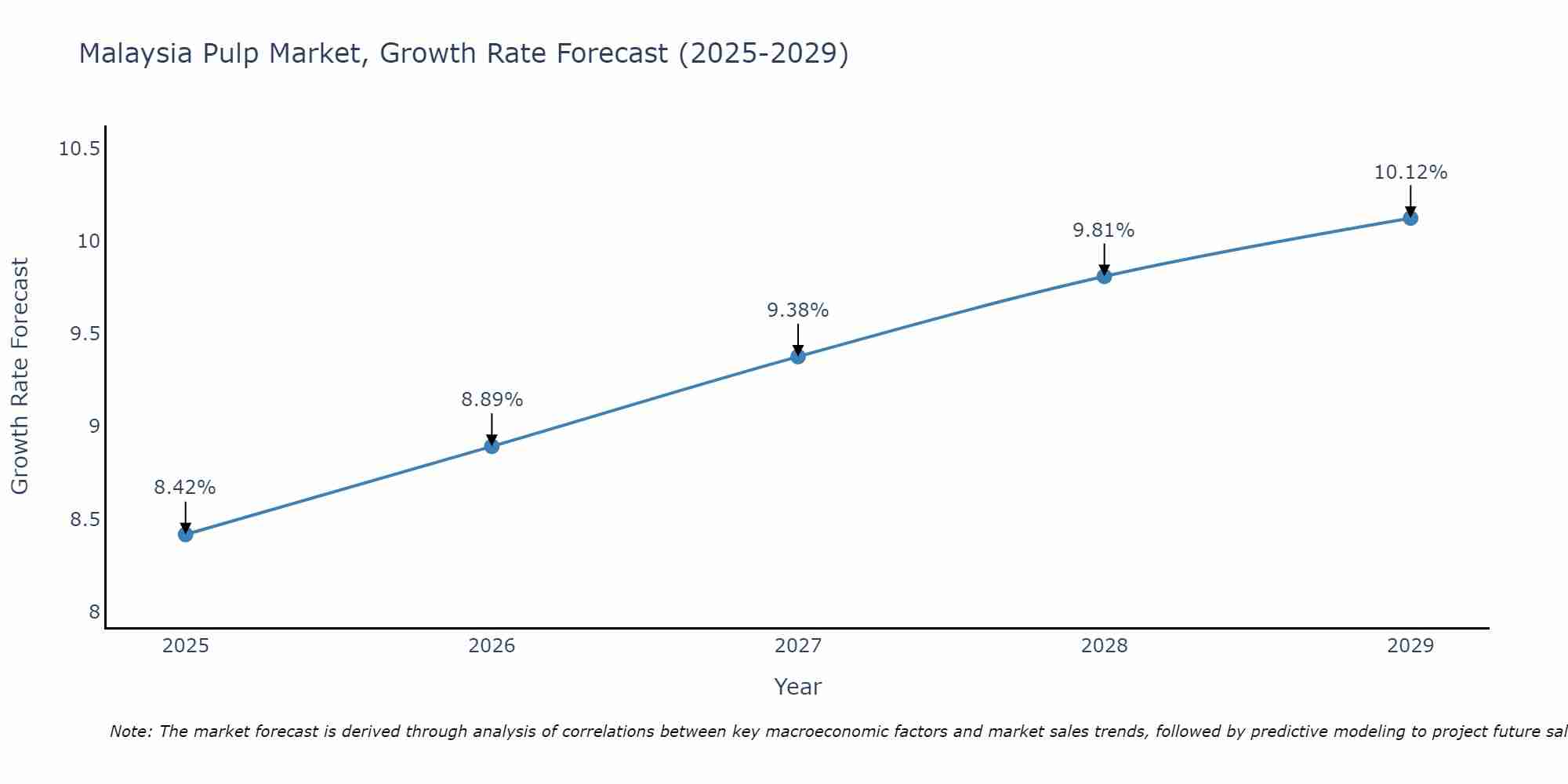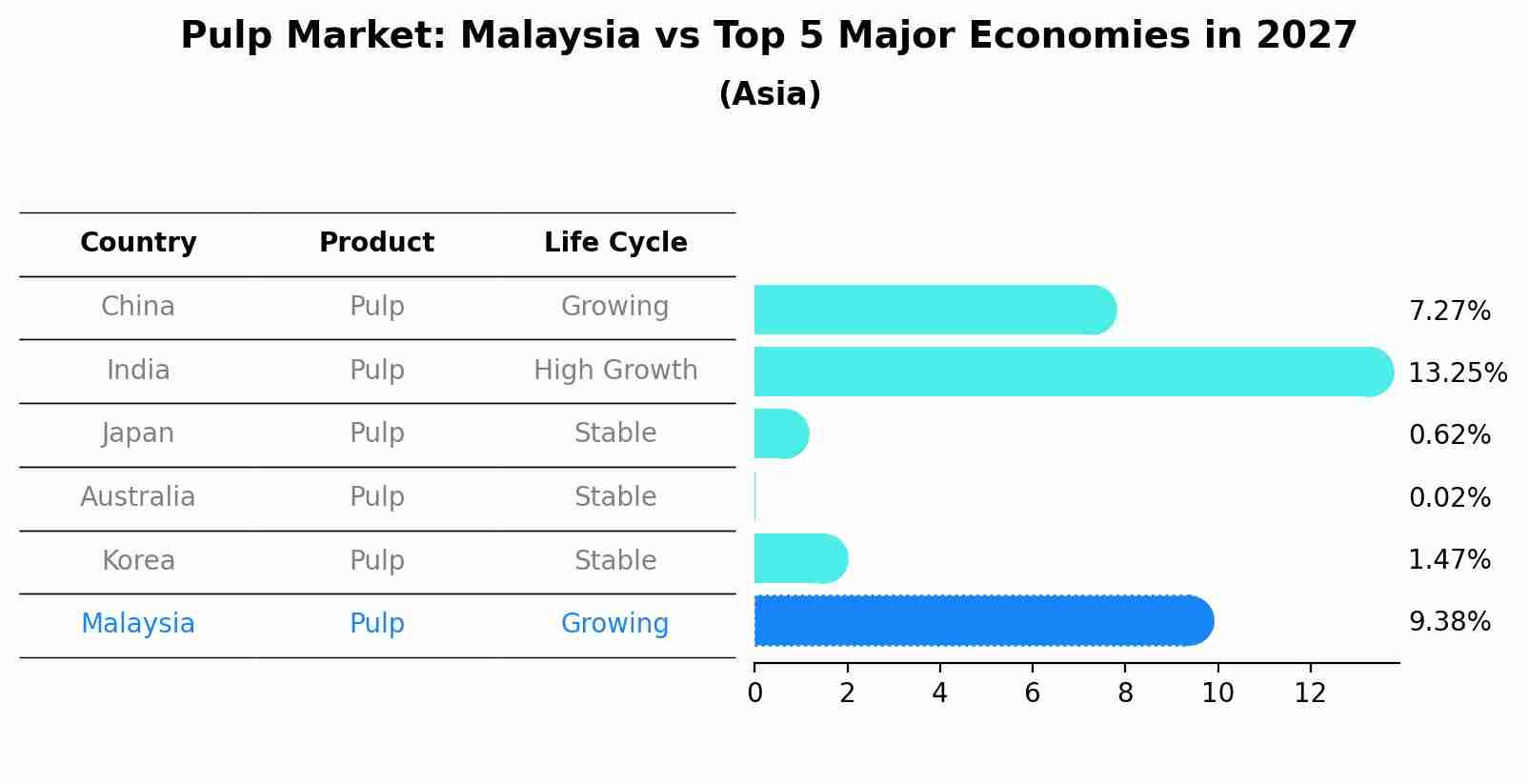Malaysia Pulp Market (2020-2026) | Revenue, Companies, Share, Value, Size, Analysis, Industry, COVID-19 IMPACT, Outlook, Trends, Growth & Forecast
| Product Code: ETC007006 | Publication Date: Jun 2023 | Updated Date: Apr 2025 | Product Type: Report | |
| Publisher: 6Wresearch | No. of Pages: 70 | No. of Figures: 35 | No. of Tables: 5 | |
Malaysia Pulp Market Size Growth Rate
The Malaysia Pulp Market is likely to experience consistent growth rate gains over the period 2025 to 2029. The growth rate starts at 8.42% in 2025 and reaches 10.12% by 2029.

Pulp Market: Malaysia vs Top 5 Major Economies in 2027 (Asia)
By 2027, Malaysia's Pulp market is forecasted to achieve a growing growth rate of 9.38%, with China leading the Asia region, followed by India, Japan, Australia and South Korea.

Malaysia Pulp Market Synopsis
The Malaysia pulp market is expected to grow at a CAGR of 3.4% from 2020 to 2026, reaching a value of USD 2.3 Billion by the end of 2026. This growth can be attributed to factors such as rising demand for paper products due to increasing population and urbanization, growing awareness regarding environmental sustainability among consumers, changing lifestyles and increasing purchasing power, and government initiatives towards promoting eco-friendly packaging solutions. Moreover, the pulp industry in Malaysia has also been supported by favorable government policies such as tax exemptions on imported inputs that are used for producing pulps domestically. Furthermore, technological advancements have led to an increase in production capacities resulting in improved quality standards and cost competitiveness.
Key Highlights of the Report:
- Malaysia Pulp Market Outlook
- Market Size of Malaysia Pulp Market, 2019
- Forecast of Malaysia Pulp Market, 2026
- Historical Data and Forecast of Malaysia Pulp Revenues & Volume for the Period 2016 - 2026
- Malaysia Pulp Market Trend Evolution
- Malaysia Pulp Market Drivers and Challenges
- Malaysia Pulp Price Trends
- Malaysia Pulp Porter's Five Forces
- Malaysia Pulp Industry Life Cycle
- Historical Data and Forecast of Malaysia Pulp Market Revenues & Volume By Types for the Period 2016 - 2026
- Historical Data and Forecast of Malaysia Pulp Market Revenues & Volume By Chemical Pulp for the Period 2016 - 2026
- Historical Data and Forecast of Malaysia Pulp Market Revenues & Volume By Mechanical & Semi Chemical Pulp for the Period 2016 - 2026
- Historical Data and Forecast of Malaysia Pulp Market Revenues & Volume By Non Wood Pulp for the Period 2016 - 2026
- Historical Data and Forecast of Malaysia Pulp Market Revenues & Volume By Applications for the Period 2016 - 2026
- Historical Data and Forecast of Malaysia Pulp Market Revenues & Volume By Corrugating Materials for the Period 2016 - 2026
- Historical Data and Forecast of Malaysia Pulp Market Revenues & Volume By Printing & Writing for the Period 2016 - 2026
- Historical Data and Forecast of Malaysia Pulp Market Revenues & Volume By Carton Board for the Period 2016 - 2026
- Historical Data and Forecast of Malaysia Pulp Market Revenues & Volume By Tissue for the Period 2016 - 2026
- Historical Data and Forecast of Malaysia Pulp Market Revenues & Volume By Newsprint for the Period 2016 - 2026
- Historical Data and Forecast of Malaysia Pulp Market Revenues & Volume By Wrapping Paper for the Period 2016 - 2026
- Historical Data and Forecast of Malaysia Pulp Market Revenues & Volume By Kraft Paper for the Period 2016 - 2026
- Malaysia Pulp Import Export Trade Statistics
- Market Opportunity Assessment By Types
- Market Opportunity Assessment By Applications
- Malaysia Pulp Top Companies Market Share
- Malaysia Pulp Competitive Benchmarking By Technical and Operational Parameters
- Malaysia Pulp Company Profiles
- Malaysia Pulp Key Strategic Recommendations
Frequently Asked Questions About the Market Study (FAQs):
1 Executive Summary |
2 Introduction |
2.1 Key Highlights of the Report |
2.2 Report Description |
2.3 Market Scope & Segmentation |
2.4 Research Methodology |
2.5 Assumptions |
3 Malaysia Pulp Market Overview |
3.1 Malaysia Country Macro Economic Indicators |
3.2 Malaysia Pulp Market Revenues & Volume, 2019 & 2026F |
3.3 Malaysia Pulp Market - Industry Life Cycle |
3.4 Malaysia Pulp Market - Porter's Five Forces |
3.5 Malaysia Pulp Market Revenues & Volume Share, By Types, 2019 & 2026F |
3.6 Malaysia Pulp Market Revenues & Volume Share, By Applications, 2019 & 2026F |
4 Malaysia Pulp Market Dynamics |
4.1 Impact Analysis |
4.2 Market Drivers |
4.3 Market Restraints |
5 Malaysia Pulp Market Trends |
6 Malaysia Pulp Market, By Types |
6.1 Malaysia Pulp Market, By Types |
6.1.1 Overview and Analysis |
6.1.2 Malaysia Pulp Market Revenues & Volume, By Types, 2016 - 2026F |
6.1.3 Malaysia Pulp Market Revenues & Volume, By Chemical Pulp, 2016 - 2026F |
6.1.4 Malaysia Pulp Market Revenues & Volume, By Mechanical & Semi Chemical Pulp, 2016 - 2026F |
6.1.5 Malaysia Pulp Market Revenues & Volume, By Non Wood Pulp, 2016 - 2026F |
6.2 Malaysia Pulp Market, By Applications |
6.2.1 Overview and Analysis |
6.2.2 Malaysia Pulp Market Revenues & Volume, By Corrugating Materials, 2016 - 2026F |
6.2.3 Malaysia Pulp Market Revenues & Volume, By Printing & Writing, 2016 - 2026F |
6.2.4 Malaysia Pulp Market Revenues & Volume, By Carton Board, 2016 - 2026F |
6.2.5 Malaysia Pulp Market Revenues & Volume, By Tissue, 2016 - 2026F |
6.2.6 Malaysia Pulp Market Revenues & Volume, By Newsprint, 2016 - 2026F |
6.2.7 Malaysia Pulp Market Revenues & Volume, By Wrapping Paper, 2016 - 2026F |
7 Malaysia Pulp Market Import-Export Trade Statistics |
7.1 Malaysia Pulp Market Export to Major Countries |
7.2 Malaysia Pulp Market Imports from Major Countries |
8 Malaysia Pulp Market Key Performance Indicators |
9 Malaysia Pulp Market - Opportunity Assessment |
9.1 Malaysia Pulp Market Opportunity Assessment, By Types, 2019 & 2026F |
9.2 Malaysia Pulp Market Opportunity Assessment, By Applications, 2019 & 2026F |
10 Malaysia Pulp Market - Competitive Landscape |
10.1 Malaysia Pulp Market Revenue Share, By Companies, 2019 |
10.2 Malaysia Pulp Market Competitive Benchmarking, By Operating and Technical Parameters |
11 Company Profiles |
12 Recommendations |
13 Disclaimer |
- Single User License$ 1,995
- Department License$ 2,400
- Site License$ 3,120
- Global License$ 3,795
Search
Related Reports
- Portugal Occupational Health & Safety Services Market (2025-2031) | Strategy, Consumer Insights, Analysis, Investment Trends, Opportunities, Growth, Size, Share, Industry, Revenue, Segments, Value, Segmentation, Supply, Forecast, Restraints, Outlook, Competition, Drivers, Trends, Demand, Pricing Analysis, Competitive, Strategic Insights, Companies, Challenges
- Netherlands Occupational Health and Safety Services Market (2025-2031) | Strategy, Consumer Insights, Analysis, Investment Trends, Opportunities, Growth, Size, Share, Industry, Revenue, Segments, Value, Segmentation, Supply, Forecast, Restraints, Outlook, Competition, Drivers, Trends, Demand, Pricing Analysis, Competitive, Strategic Insights, Companies, Challenges
- Belgium and Luxembourg Facility Management Market (2025-2031) | Strategy, Consumer Insights, Analysis, Investment Trends, Opportunities, Growth, Size, Share, Industry, Revenue, Segments, Value, Segmentation, Supply, Forecast, Restraints, Outlook, Competition, Drivers, Trends, Demand, Pricing Analysis, Competitive, Strategic Insights, Companies, Challenges
- Russia Women Intimate Apparel Market (2025-2031) | Strategy, Consumer Insights, Analysis, Investment Trends, Opportunities, Growth, Size, Share, Industry, Revenue, Segments, Value, Segmentation, Supply, Forecast, Restraints, Outlook, Competition, Drivers, Trends, Demand, Pricing Analysis, Competitive, Strategic Insights, Companies, Challenges
- Africa Chocolate Market (2025-2031) | Size, Share, Trends, Growth, Revenue, Analysis, Forecast, industry & Outlook
- Global Hydroxychloroquine And Chloroquine Market (2025-2031) | Industry, Trends, Size, Outlook, Growth, Value, Companies, Revenue, Analysis, Share, Forecast
- Saudi Arabia Plant Maintenance Market (2025-2031) | Industry, Size, Growth, Revenue, Value, Companies, Forecast, Analysis, Share & Trends
- Taiwan Electric Truck Market (2025-2031) | Outlook, Industry, Revenue, Size, Forecast, Growth, Analysis, Share, Companies, Value & Trends
- South Korea Electric Bus Market (2025-2031) | Outlook, Industry, Companies, Analysis, Size, Revenue, Value, Forecast, Trends, Growth & Share
- Africa Low Temperature Powder Coating Market (2025-2031) | Companies, Competition, Size, Challenges, Segmentation, Trends, Competitive, Industry, Supply, Strategy, Investment Trends, Growth, Segments, Restraints, Strategic Insights, Revenue, Share, Forecast, Drivers, Analysis, Pricing Analysis, Demand, Consumer Insights, Value, Opportunities, Outlook
Industry Events and Analyst Meet
Our Clients
Whitepaper
- Middle East & Africa Commercial Security Market Click here to view more.
- Middle East & Africa Fire Safety Systems & Equipment Market Click here to view more.
- GCC Drone Market Click here to view more.
- Middle East Lighting Fixture Market Click here to view more.
- GCC Physical & Perimeter Security Market Click here to view more.
6WResearch In News
- Doha a strategic location for EV manufacturing hub: IPA Qatar
- Demand for luxury TVs surging in the GCC, says Samsung
- Empowering Growth: The Thriving Journey of Bangladesh’s Cable Industry
- Demand for luxury TVs surging in the GCC, says Samsung
- Video call with a traditional healer? Once unthinkable, it’s now common in South Africa
- Intelligent Buildings To Smooth GCC’s Path To Net Zero













